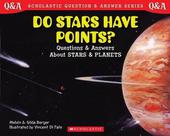
|
Do Stars Have Points? (Pb)
Paperback / softback
Main Details
| Title |
Do Stars Have Points? (Pb)
|
| Authors and Contributors |
By (author) Melvin Berger
|
|
By (author) Gilda
|
| Physical Properties |
| Format:Paperback / softback | | Pages:48 |
|
| ISBN/Barcode |
9780439085700
|
| Classifications | Dewey:523 |
|---|
| Audience | | Children / Juvenile | | Primary | |
|---|
| Illustrations |
Illustrations, unspecified
|
|
Publishing Details |
| Publisher |
Scholastic US
|
| Imprint |
Scholastic US
|
| Publication Date |
1 August 1999 |
| Publication Country |
United States
|
Description
From simple questions like "How hot is the sun?" to more complex ones like "Is there life elsewhere in the solar system?" this book helps kids understand what they see when they look up at the sky. So many mysterious things appear when we look up at the sky. And then there are the bodies we can't even see. Learning about the universe helps us understand our own planet. Children will find out about stars, planets, comets, meteors, and more. The authors provide answers that help children understand the scale, movements, and complicated relationships of objects in our universe and beyond.
Author Biography
Melvin and Gilda Berger are the authors of more than two hundred books for children. Their books have received awards from the National Science Teachers Association, the Library of Congress, and the New York Public Library. The Bergers live in New York.
ReviewsBooklist, November 1, 1999: "Each book in the Scholastic Question and Answer series focuses on a particular area of science, asking questions related to the topic and answering each query with one or more paragraphs of pertinent information. Although the idea has been tried before, this series works better than most in that it organizes the material well, it asks questions that children may actually have posed, and the answers are clear and precise. Stars introduces topics in astronomy, from "Do asteroids ever strike earth?" to "Is there life elsewhere in the solar system?" The Bergers are being responsible as they qualify some replies with phrases such as "Most scientists think." Often dramatic and beautiful, the paintings illustrate the text quite effectively. Flies explores the world of insects, answering questions such as "Do insects have tongues?" and "How can you tell a moth from a butterfly?" The colorful illustrations are detailed, vivid, and well conceived. A science series attractive enough for browsers, yet solid enough to help support the curriculum."-Carolyn PhelanSchool Library Journal, December 1999."These series entries will answer many of the questions children have about the subjects covered. . . The student-friendly questions-and-answer format is appealing, with simple and concise one or two paragraph answers and attractive, colorful illustrations. Basic up-to-date information presented in a chatty, readable style."-Eunice Weech
|